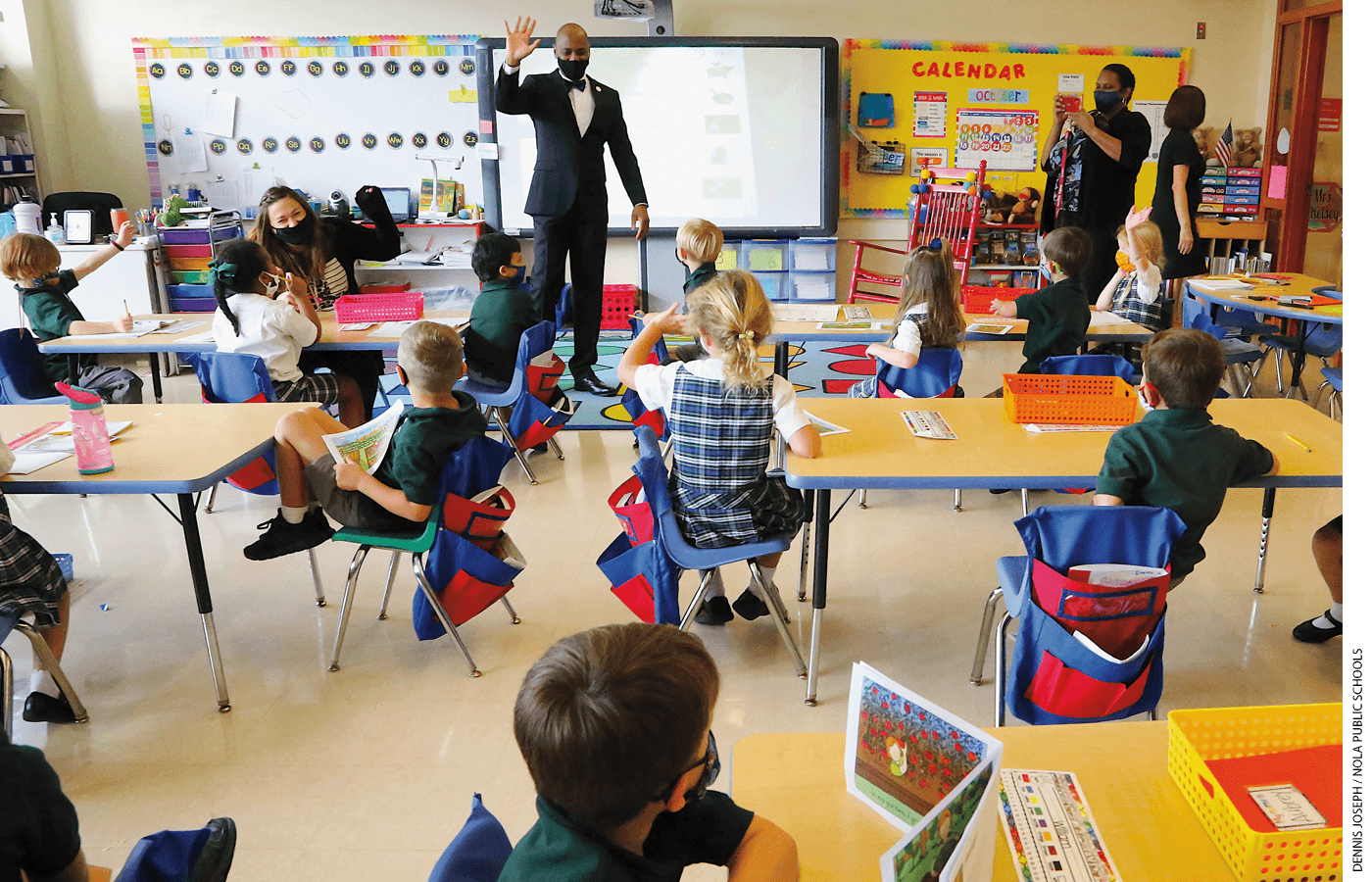
“Bad old OPSB.”
When I started working as an education reporter in New Orleans in late 2012, I heard that phrase time and time again. The city was then seven years into the post-Katrina education revolution that wrested control of the public schools from the seven-member Orleans Parish School Board. Unheard-of academic gains followed the city’s switch to a near-universal charter-school system, yet returning to failure always felt as close as the next hurricane. Give OPSB power again, people said, and the schools would slide right back where they started.
School-board candidates who wanted the district to resume its old role and who railed against charters, calling them privatized education benefiting billionaires, lost in election after election, including in fall 2020. But as schools shuffled students back and forth between in-person and virtual schooling, amid a resurgence in Covid-19 cases and revitalized calls for racial justice, something unexpected happened. After 15 years of hemming in the district, people started wanting it to do more.
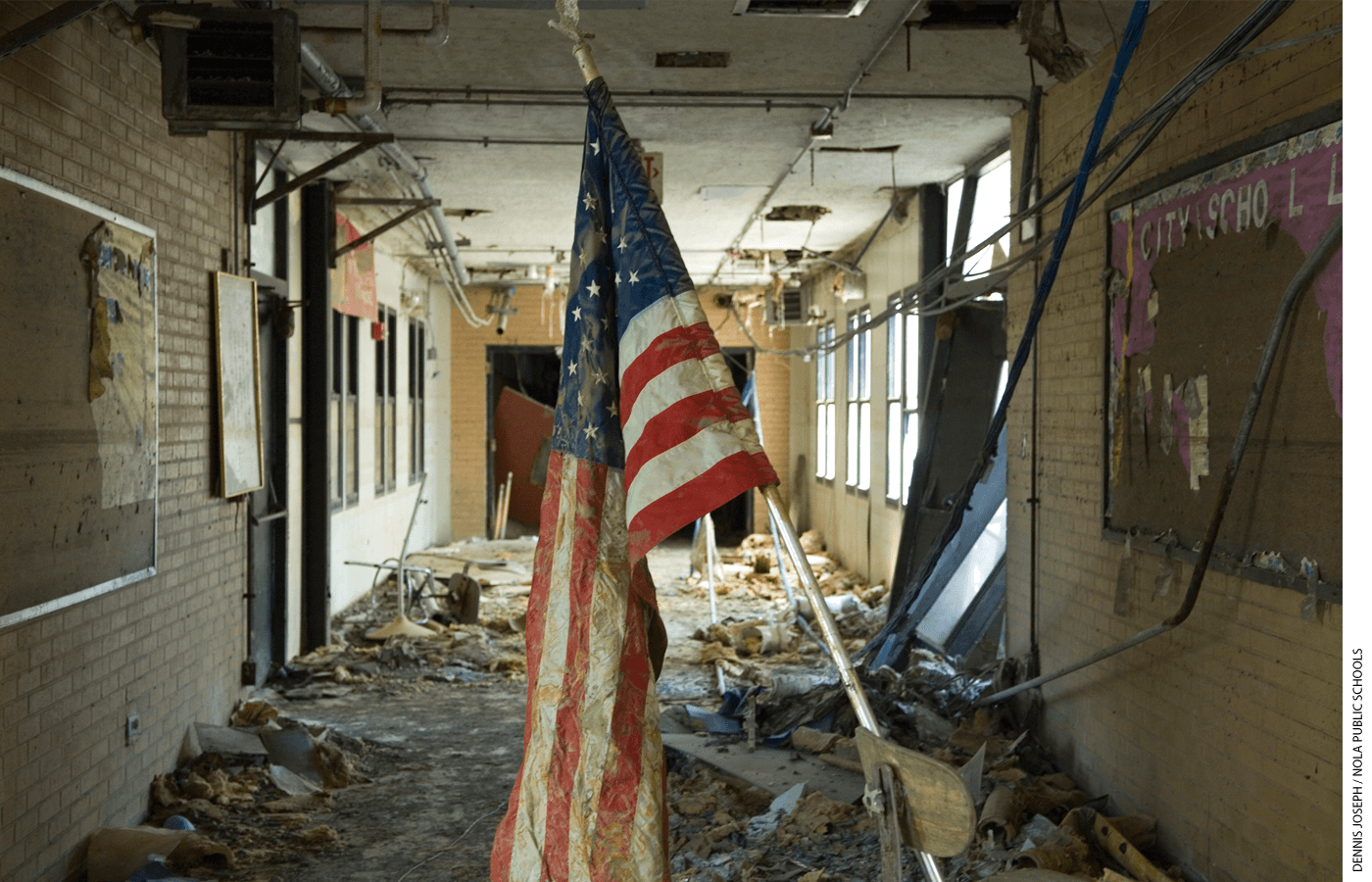
Dramatic Turnaround
Academically and financially bankrupt, under federal investigation, at best ineffectual and at worst corrupt, the pre-2005 New Orleans school district was the worst in Louisiana. Almost half of its 66,000 students attended a school that earned less than 50 points on the state’s 200-point report card. Only 54 percent graduated from high school. Many people fled: enrollment fell by 15,000 students in the 10 years before Hurricane Katrina.
Teachers struggled to do what they could, driven by passion for the work or, in some cases, just the steady paycheck. Some people tried to attack the problem from a new angle. A few groups started charter schools, gaining the freedom to hire, fire, and teach as they wanted. At the same time, Louisiana created the Recovery School District to take over and charter out struggling schools. But there was no sign that any major power shift loomed. When the 2005–06 school year began, the Recovery School District controlled only a handful of schools. Then, during the last week of August 2005, Hurricane Katrina hit.
With hundreds of thousands of residents evacuated and campuses flooded with up to 12 feet of water, the school board abandoned ship. It said there was no way to reopen schools that academic year. The Orleans Parish School Board laid off more than 7,000 employees, sending pink slips to mailboxes that had been literally washed away. But the school closures opened up an opportunity for change. The Recovery School District seized four fifths of the city’s schools, and most of the schools remaining under the OPSB’s auspices went charter as well. The city eliminated traditional student assignment by home address and instituted universal school choice, allowing any student to apply to any school.
It was one of the biggest transformations in U.S. education, arguably surpassing even the 25-year state takeover in Newark: there, at least the buildings stayed mostly the same, whereas the decrepit New Orleans campuses took such a hit in the storm and flood that FEMA allotted $1.8 billion to rebuild.
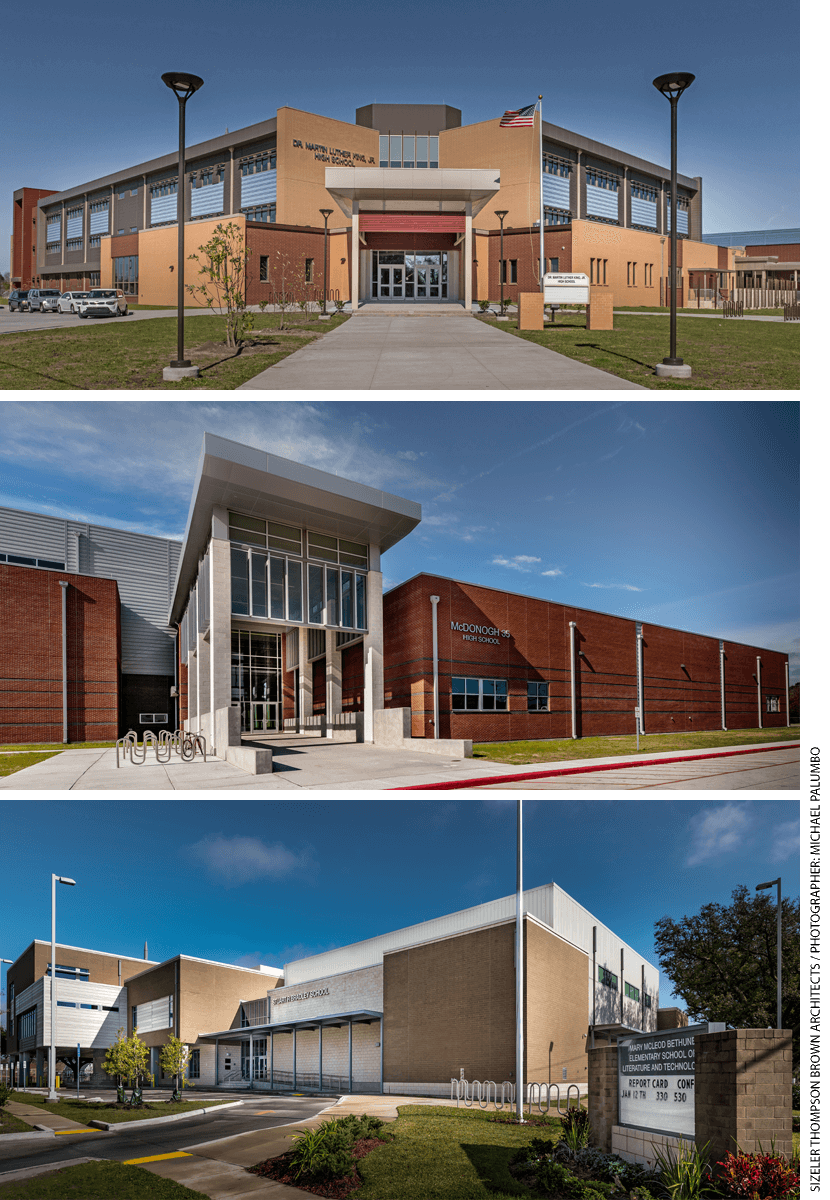
Support poured in: foundation money, federal grants, eager young teachers. Many schools never reopened, including the New Orleans Free School, a place where students got written evaluations instead of grades and called teachers by their first names. Logan Crowe, a teacher there, described the school as “alternative before the word ‘alternative’ meant prison.” Orleans Free started privately on the ground floor of a commune, then fought to keep its creative approach going once it joined the district. After it closed, Crowe signed on as assistant principal at Alice Harte Elementary and then became principal and CEO of the Recovery District’s Andrew H. Wilson Charter, in a newly renovated building. “Orleans Parish schools needed to change,” Crowe said, looking back now. “And I think a lot of them did.”
Charters stayed in business only if they met academic benchmarks and attracted enough students. And, indeed, scores shot up. The city saw a “stretch of improvement I’ve still never seen anywhere else,” said Doug Harris, director of the Education Research Alliance for New Orleans at Tulane University. Those results were real, his team concluded—not the result of changed demographics, largescale cheating, teaching to the test, or increased funding. “I thought, this can’t be right. There must be something else going on here that we’re not seeing. But we just couldn’t find anything like that,” Harris said.
Where was the Orleans Parish School Board in all this? Squabbling over crumbs. In combative meetings, the members fought over who would be superintendent. They disparaged the Recovery School District charters and the children in them. They fought with RSD over the FEMA rebuilding plan. Two Orleans Parish School Board members went to prison, five years apart, on federal conspiracy charges.
Successful Recovery charters had the option to return to Orleans Parish oversight and declined, fearing it would damage their gains.
Finally, 10 years after Katrina, the school board hired Henderson Lewis Jr. as superintendent and fell in line behind him. Lewis was a new kind of superintendent, low on charisma, not a king, but a manager who had taught in the Recovery system and embraced the so-called portfolio model. In fact, he chartered out the district’s final traditional schools. The school board began passing policies similar to the Recovery School District’s—for instance, requiring all its charters to join the computerized common-enrollment system when the schools’ contracts were renewed. School board meetings became normal, even boring.
In spring 2016, Lewis and Patrick Dobard, superintendent of the Recovery District, went before the Louisiana legislature and asked lawmakers to reverse the post-Katrina takeover. They said that OPSB would run like the Recovery system, giving wide latitude to the charters—that parents and students wouldn’t even notice the difference. It would be a new kind of decentralized district, one that would regulate, not rule. They promised that OPSB would not screw it up.
“We are ready,” Lewis said.
Even a supporter of the reunification bill, New Orleans State Representative Walt Leger, sounded less than enthusiastic. “There are many people, parents and others, who are not thrilled about schools returning to the Orleans Parish School Board,” he said, but “at some point, whether we like it or not, the schools need to be returned to the local authority, and now is as good a time as any, in my opinion, to get started on that process.” The legislature approved the end of the takeover, with a two-year runway. In 2018, the district reunified. (A handful of state-authorized charters that had never been part of Orleans Parish remain under the oversight of the state’s board of elementary and secondary education.)
To herald the new era, the district rebranded the system as NOLA Public Schools. For about two years, things ran pretty smoothly, with the usual fretting over test scores and charter renewals. Then Covid-19 hit, intensifying the underlying problems. The district stepped forward to coordinate the response. And the people I interviewed for this article began wanting the district to wield more power again, to step up and create a vision and a road map for a city whose schools truly flourished.
In November 2020, for the first time since before Katrina, all seven school board seats were contested. Three members won re-election: Ethan Ashley, John Brown Sr., and Nolan Marshall Jr. They were joined by newcomers Katie Baudouin, Olin Parker, J. C. Romero, and Carlos Zervigon. All have or have had children in New Orleans public schools.
Among the unsuccessful candidates, Kayonna Armstrong favored returning to a system of schools directly run by the school board, Chanel Payne called for a moratorium on charters, and Antoinette Williams supported direct-run schools along with independent charters. All of the winning candidates favored maintaining the all-charter model.
Olin Parker left his job running charter schools for the State of Louisiana to run for the school board seat. “I saw the limits of what you can do from the state government side,” he said. “I think OPSB still has a huge role to play.”
In 2018, that would have sounded faintly ridiculous or a little threatening. Not anymore.
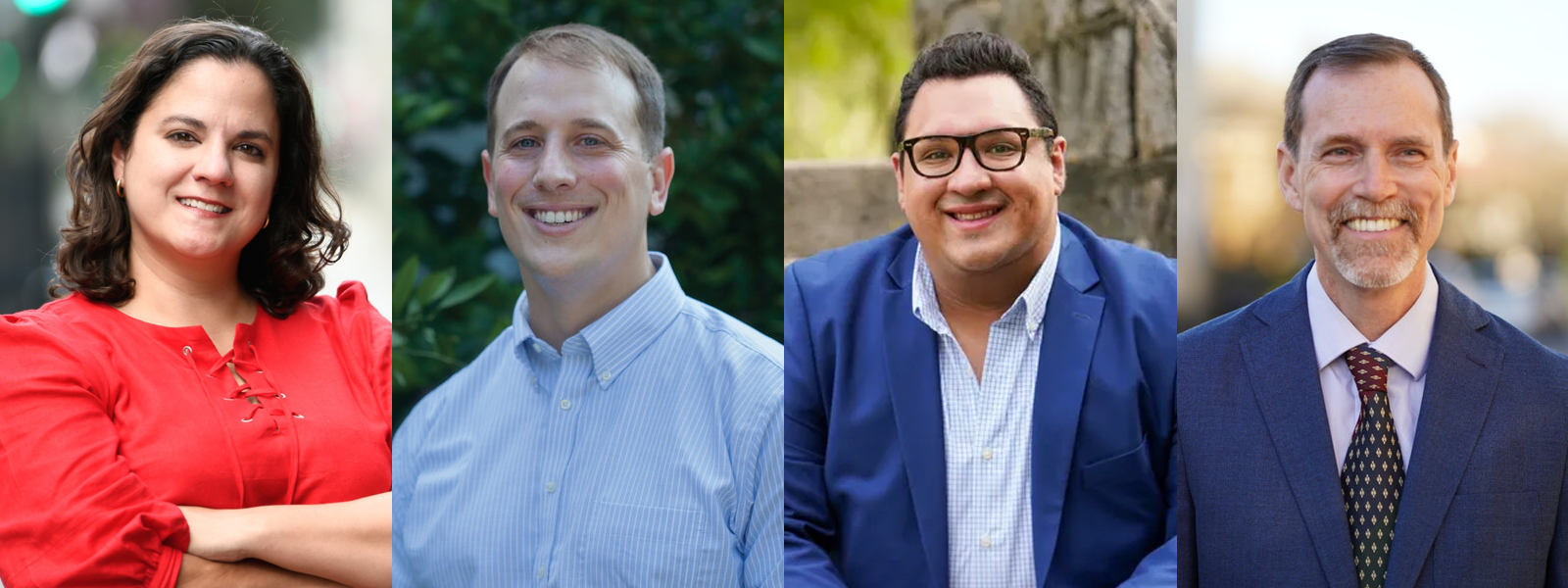
Still a Long Way to Go
Even before the Covid-19 pandemic, academic improvement had stalled in New Orleans. In fact, it “pretty much plateaued around 2013,” Harris said (though he also suggested that “you could reframe ‘stagnation’ as ‘maintained improvement.’”) As of 2017, 16 percent of the city’s 16- to 24-year-olds were neither in school nor working, according to the Opportunity Index. At last count, one third of students attended schools rated D or F by the state. At most New Orleans high schools, the class of 2020, whose entire academic career took place in the post-Katrina system, averaged less than a 17.5 out of a possible 36 on the ACT. That’s too low to get a student admitted to either of the city’s four-year public universities.
The mediocre scores are no secret. “We all say the same thing: We’ve come a long way, but there’s so much to be done,” said Caroline Roemer, director of the Louisiana Association of Public Charter Schools.
What’s more, Harris’s Education Research Alliance found that most of the academic improvement happened when a new charter group took over a school. Even though the school board lets students stay at their school when management changes, takeovers are grueling for all involved. Teachers often lose their jobs or leave; students have to acclimate to changes in school operations and culture; parents have to deal with a new set of administrators, and everyone has to live with the fear that the takeover won’t help, because sometimes they don’t. Joseph Craig Charter is on its third manager in 15 years, and 42 Charter School is on its fourth. Also, takeovers don’t happen very often now, unlike in the early years of Recovery School District operation. Only one of the city’s charters is changing hands during the summer of 2021: Crocker, moving to its third manager.
The shortage of good schools puts pressure on parents. Newly elected board member Katie Baudouin said she began thinking about running for the office during the tension of waiting for her older child’s results on OneApp, the computerized common application that matches students with seats. Though the system allows preferences for siblings and children who live near a school, for most families it’s a game of roulette, with bad odds for the most popular schools. The parents of 830 four-year-olds applied for A-rated Hynes Charter’s 55 open kindergarten seats for fall 2019, and almost 2,500 rising 9th graders sought 262 spots at A-rated Warren Easton, the district reported. Many parents told Tulane’s Cowen Institute that they didn’t like the OneApp common-enrollment system, but most said that was because they didn’t get the school they wanted. A large number of families continue to opt out of the public system altogether: one quarter of New Orleans children currently attend private school, according to the Cowen Institute.
While the Orleans Parish School Board is officially back in charge, its ability to remedy a school’s ills is very limited. That’s because the state legislation that restored local control also prohibited the district from doing much of the work that districts traditionally do—including exercising authority over charter schools’ “programming, instruction, curriculum, materials and texts, yearly school calendars and daily schedules, hiring and firing of personnel, employee performance management and evaluation, terms and conditions of employment, teacher or administrator certification, salaries and benefits, retirement, collective bargaining, budgeting, purchasing, procurement, and contracting for services other than capital repairs and facilities construction.” If student test scores start slipping, solutions are up to the charter manager.
In an all-charter system, “the role of the board becomes selecting operators and determining what kind of schools we want to have and who’s going to run them,” Harris said. “They’re always grappling at the margins.”
However, OPSB can help all schools to address the problems that hurt students across the board, former Recovery superintendent Dobard said, such as inadequate preschool services and high teacher turnover.
These efforts have begun in a small way. The previous board decided to use tax dollars to improve teacher recruitment and retention across the system and to train school staff to help traumatized children. Many school board candidates, successful and not, promised to focus on students’ mental health. “It’s no secret that there is a lot of trauma in our school system,” board member Parker said.
Data from the city’s Institute of Women and Ethnic Studies back that up. Among 2,800 middle- and high-school students the institute surveyed over several years, 27 percent said they had been exposed to violence against a parent or sibling; 12 percent said they had considered suicide; and 46 percent said they had experienced the murder of someone close to them. Even before Covid-19 knocked parents out of work, Louisiana considered 84 percent of the city’s public-school students to be “economically disadvantaged,” a category that includes those who are eligible for a range of public benefits as well as students who are homeless, in state custody, or not fluent in English.
Jamar McKneely, head of the InspireNOLA charter group, is one of many charter leaders who focused for years on addressing problems within school walls. He’s now talking about tackling poverty and homelessness directly. He’s been in education long enough that he’s now seeing the children of his original students. Too often, those parents haven’t managed to fulfill their dreams, he said.
“We have too many Black and brown families who are below the poverty line. The incarceration rate is still too high. When I look at the homeless rates, they’re still too high. That shows that not just from an academic standpoint, but from a social-economic standpoint, there’s still a lot of work to do that I would love to see this board start to tackle,” McKneely said. OPSB “can’t just be a board focusing strictly on academics.”
Among those societal problems, one stands out as the biggest, or perhaps the most foundational. The city is experiencing two pandemics, board member Ethan Ashley said: Covid-19 and “the pandemic of systemic racism.”
Although New Orleans takes pride in its long history of gens de couleur libres—free people of color—generations of racial discrimination have resulted in persistent poverty and lack of progress.
The school system also has a history of racial inequality and unfairness. During the Jim Crow era, the all-white OPSB invested in white campuses while squeezing Black children into shabby buildings for part-day shifts. In 1948, 1,000 students attended Sylvanie Williams Elementary, where only two classrooms had electric light, according to historian Walter Stern’s 2018 book Race and Education in New Orleans.
After four brave African American girls enrolled at two white schools in 1960, what resulted was not integration but white flight. In 2005, 7 percent of the student body was white, and 9 in 10 of those white students attended the top-ranked schools, most of which had entrance requirements. Fourteen years later, white students made up 9 percent of the student body, and 8 in 10 attended schools rated A or B, according to data from the Louisiana Department of Education. Four percent of white children, but 41 percent of Black children, went to a D or F school. Like the city itself, the school population is significantly less Black now, but the difference is due to increased Hispanic enrollment, which has risen to 11 percent from 1 percent.
In addition, the people standing in front of and behind those students don’t reflect the students’ diversity. As an employer, the pre-Katrina district was the backbone of the Black middle class; indeed, some critics have charged that a goal of the state takeover was to disempower African Americans. Now a bare majority of teachers and principals are Black; fewer than 4 in 10 charter groups have a Black CEO; and 14 percent of charter groups have both a Black CEO and a Black-majority board, according to Black Education for New Orleans.
Being taught by a proportionally diverse group of educators can make a difference for Black children. Cultural competence “is different from rapping a math lesson,” said Adrinda Kelly, the director of Black Education for New Orleans. Studies show a range of benefits for students of color whose teachers look like them, from fairer discipline to higher test scores and greater enrollment in gifted classes. In a survey by Doug Harris’s group, New Orleans students rated their teachers lower on quality than the national average. Half the Black respondents thought their teachers showed concern for their well-being or valued their ideas.
Some organizations are working on diversifying the teaching corps. Black Education for New Orleans coaches educators at Black-governed schools and offers professional development for Black teachers. New Schools for New Orleans runs a teacher residency with Xavier, the nation’s only historically Black Catholic university.
The school board is acting on this issue as well. The previous board hired Beloved Community, a Black-led anti-racist education consultancy, to carry out a districtwide racial-equity audit that addresses both the central office and individual schools. All seven of the current board members have pledged to carry out Beloved Community’s recommendations and to create incentives for schools to improve racial equity. Board member Ashley said he is excited about the audit, which he calls “historic.”
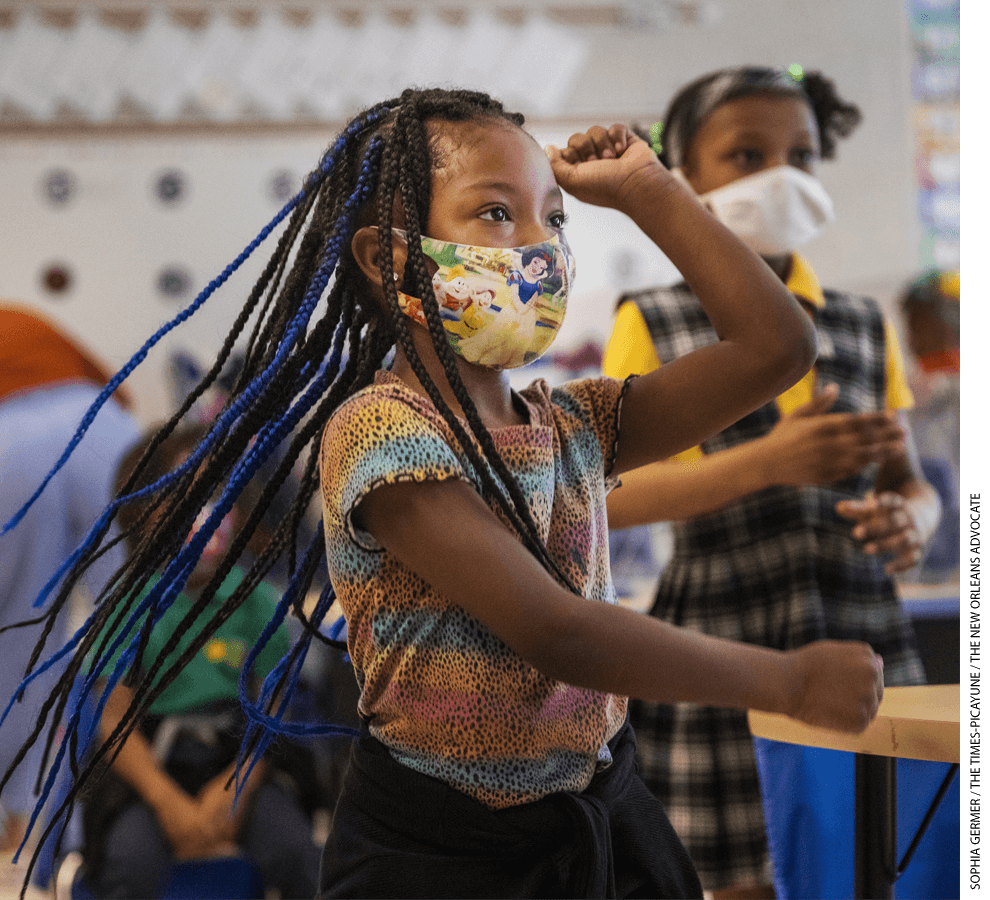
Vision and Community
Facing these challenges, charter schools in New Orleans need OPSB now as they haven’t before. Charter leaders such as FirstLine Schools CEO Sabrina Pence and charter fans such as former Louisiana state education superintendent John White are asking for leadership from the board, but a different kind of leadership this time—not with the iron fist wielded by bad old OPSB, but through a new focus on collaboration, inspiration, and vision.
For progress to resume, the schools are going to need money. School funding depends on sales and hospitality taxes, and oil and gas revenue, all of which are suffering. “The financial picture is kind of grim,” said Pence. FirstLine’s founders opened the city’s first charter school in 1998; the network now runs five schools.
“We’re going to have to ask for help from our elected officials to effectively bring home the bacon,” board member Ashley said.
Charters also need flexibility in academic standards. Currently, charter renewal relies almost entirely on a school’s performance score, which derives from students’ standardized test scores, graduation rates, and the amount of advanced coursework a school offers. In New Orleans as in the rest of the nation, children are losing ground because of the pandemic’s educational and personal disruptions, and charter authorizers will need to take that context into account.
No one used to talk about accountability more than former state chief White, who lives in New Orleans with his young family. But now he’s talking about the need to take a broader view. “We’re going to have a lot of kids with a lot of challenges at home who need to learn to read and who haven’t been consistently in school,” he said. “How do we define recovery? What is it that schools should be focused on?”
Pence agreed. The old model doesn’t work right now, she said. And the solution can’t be top-down. “The community has ideas about what a good school is beyond academics,” and they want input, she said.
Logan Crowe couldn’t agree more. The school he ran, Andrew H. Wilson, lost its charter in 2015 over low performance, and InspireNOLA took it over. Several jobs later, Crowe has returned to his roots with The NET’s new alternative middle school. (The network’s name stands for “meeting Needs, raising Expectations, Training for life.”) Most New Orleans schools are similar to one another, and not everyone fits their mold, he said. “I think that’s shut a lot of people out,” he said. “There need to be more choices for students and families who just want something different.”
Though the hallmark of charter schools is autonomy and competition—and Pence, for one, still wants to run her own bus routes—an all-charter district can’t be each out for its own, said InspireNOLA’s McKneely. “We have to start looking at this from a systematic standpoint, not just one organization. I think if we do that more, then holistically our city will fare a whole lot better.”
Charter groups have been working together and with the district for several years now, first to develop the common-enrollment system, then to work out the details of the reunified district, and now to coordinate services during the pandemic. The work done during the crisis illustrates an especially public and effective model for cooperation. The initial ramp-up for remote teaching and learning “was definitely a collective process,” McKneely said, involving many, many conference calls. The district led the push for technology, swiftly acquiring 10,000 laptops and 8,000 hotspots, which charters distributed to needy students, according to a district press release. Charters worked with their own meal providers to get food to families, and the district ran interference to ensure that the schools would be reimbursed through the federal lunch program. Lewis and the previous board kept up with the latest Covid-19 information from the city and healthcare systems, and set reopening timelines and basic safety guidelines with the charter leaders’ consent. For the first time, almost all the city’s charters agreed to a common school calendar and made a unified decision about whether to hold classes virtually or in-person. It might not be a coincidence that parents’ goodwill toward the school system has gone up, according to an October 2020 poll by the Cowen Institute.
“They just hit it out of the ballpark,” said the Louisiana Association of Public Charter Schools’ Caroline Roemer of the transition to distance learning. “So many districts failed to do the basics.”
The school board can’t force this kind of collaboration, because legally it doesn’t have much muscle. But the board can persuade. It can advise. It can convene meetings to search for solutions. “You’re not forcing people. You’re bringing them together,” White said.
The fear of what happens if OPSB doesn’t act has begun to overshadow anxiety about what could happen if it does act. “The city, as with all cities, needs leadership right now,” White said. “These are real challenges. They require collective solutions and collaboration . . . [and] really, only the superintendent and the school board are empowered to facilitate that sort of solution at that scale.”
“I would like to see them really create a bold vision that would carry us beyond the progress that has been made the past 15 years. And it’s time for it now,” McKneely said. He added a thought that would once have been anathema for a charter CEO: in a pandemic or a hurricane, “some of us still believe that there’s nothing wrong at certain times for the superintendent of Orleans, who has been appointed by the board, [to] make some decisions that are critical to the wellbeing of the whole system.”
“There’s a real opportunity for building and setting the vision for the next five years, for the city. That’s got to be the main priority,” Pence said. “Strong community engagement is critical so that people really have deep confidence in what that system looks like.”
The elected, local school board is “accountable to the community,” she added. “And having a path forward that is charted out [and] that has had wide engagement I think could be a huge, huge win.”
Can big, bad old OPSB, now in charge of shiny NOLA Public Schools, live up to those hopes?
Superintendent Lewis said yes, and that the Covid-19 response showed it. “We’re able to bring people along,” he said—to convene a school community around common problems, build relationships, and help with resources. “The last thing I want to say is, ‘My role is regulation and authorization, I’m just going to sit back and wait till you fail.’”
Board President Ashley agreed with Lewis’ assessment. The new board is “up to the task,” he said. “But it’s not going to be easy.”
Danielle Dreilinger is an education journalist based in New Orleans and the author of The Secret History of Home Economics: How Trailblazing Women Harnessed the Power of Home and Changed the Way We Live (May 2021).
This article appeared in the Summer 2021 issue of Education Next. Suggested citation format:
Dreilinger, D. (2021). What’s Next in New Orleans: The Louisiana city has the most unusual school system in America. But can the new board of a radically decentralized district handle the latest challenges? Education Next, 21(3), 32-40.


